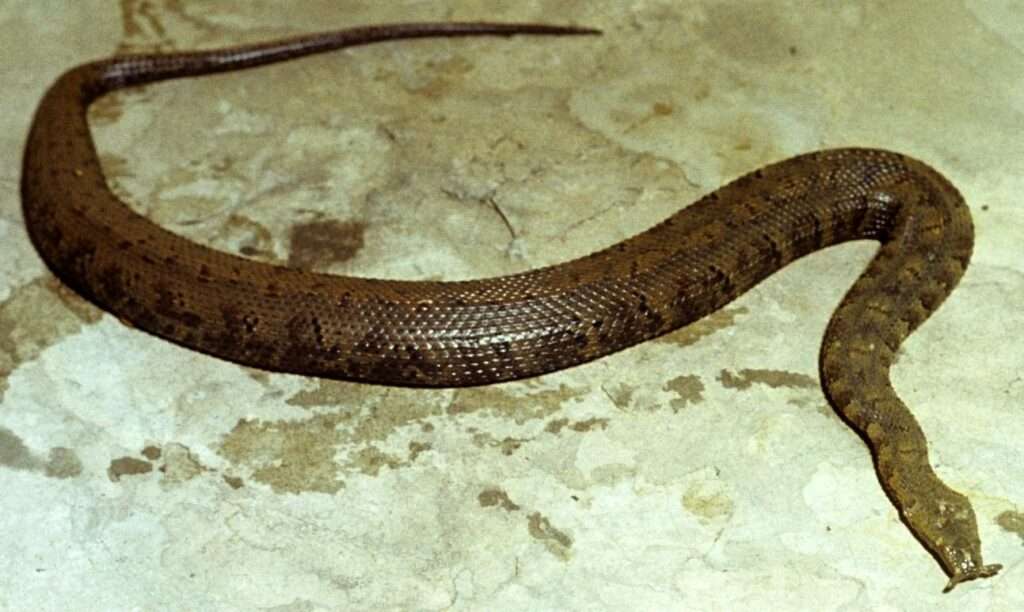
Description:
Scientific name: Erpeton tentaculatum
Life span: 14 years
The tentacle snake (Erpeton tentaculatum) is a kind of aquatic snake with rear-fanged teeth. They are known to exist in two colour phases: striped and blotched, both of which range from dark grey or brown to light tan. It spends its whole existence in gloomy water.
Native Region/Habitat
The tentacled snake is a native of Southeast Asia, and it may be found in Thailand, Cambodia, and Vietnam.
Behavior:
Tentacled snakes live their entire lives under the water and are capable of submerging themselves for up to 30 minutes without needing to surface. They are only able to move clumsily on land. The snake may bury itself in the mud at night or during periods of dry weather.
Hunting is done using a special ambush technique. Tentacled snakes maintain a stiff posture for a large portion of the day. The animal’s body takes on the recognizable upside-down “J” configuration, and the tail is utilized to anchor it underwater. Even when a person grabs or moves the snake, it will maintain this shape—an apparent freeze reflex. The limited area from its head, somewhat towards its body, is the striking range.
Hydrophones and high-speed cameras are used to better understand how the snake ambushes prey. The snake predicts the fish’s motions as it tries to flee. The snake moves a portion of its body posterior to its neck when the fish swims into range, stirring up the water. The C-start escape reflex, in which the fish twists its body into a “C” shape, is triggered by this disruption. Ordinarily, the fish would swiftly straighten its body to swim away from the disturbance, but the snake snatches it, generally by the head, anticipating its movement.
Care As a pet/In captivity:

Enclosure: A 20-gallon “long” tank can accommodate one adult tentacled snake, however I’ve discovered that this species thrives when housed in small groups. A typical 55- to 60-gallon aquarium can house up to four fish. Seven tentacled snakes fit easily in a 125-gallon tank. The aquarium’s surface area is more significant than its height, but because tentacled snakes are skilled escape artists, the aquarium must be tall enough to allow for a sufficient water depth and space between the water and the top of the tank.
Temperature and Light: Although care must be taken, an underwater aquarium heater (like the Aqueon Submersible Aquarium Heater) can be used to keep the water temperature between 77 and 82 degrees throughout the year. Simple ambient lighting or fluorescent tubes placed above the tank might be used for lighting. If an aquarium heater is used to heat the water, heat lights are not required.
Humidity: A tentacled snake enclosure should have a humidity level of between 55% and 60%. If the water heater is adjusted to the proper temperature, the water naturally evaporating from the tank maintains the enclosure’s humidity levels.
Food and Water: In captivity, tentacled snakes prefer eating live food like tiny feeder fish. A tentacled snake will eat bettas, rosy barbs, feeder goldfish, minnows, mollies, and guppies among other things. Set up a tank with 30 to 50 fish so that the tentacled snake can eat anytime it wants to (the snakes usually eat 20 to 30 2-inch fish per week). If the fish supply runs out, replenish it.
The food of young tentacled snakes is the same as that of adult snakes. To prevent the fish from hurting the snake, make sure the feeder fish are no larger than one-fourth the snake’s length. As tentacled snakes spend the most of their time submerged in water, they don’t require a separate water bowl.
Table





